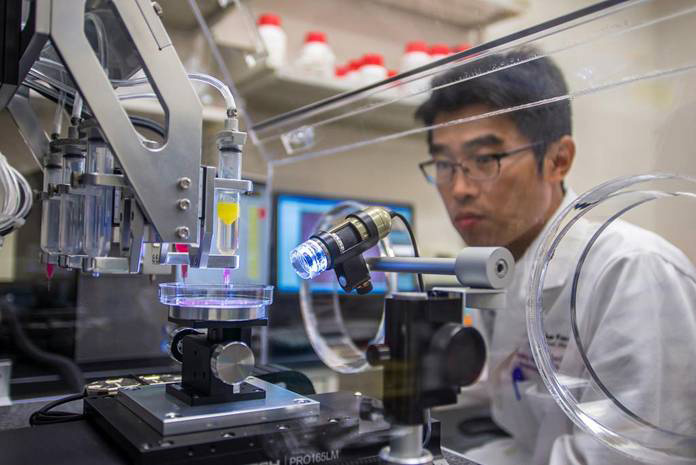|
Most science fiction fans imagine the future of medicine as something like the automated operating capsule in Prometheus or the real-time virtual reality body scans on Star Trek: Discovery, but maybe you’re not aware how far along we’ve come in the journey towards realizing some of these feats.

Photo: Army Medicine; Creative Commons License
Research by Taiwan’s Industrial Technology Research Institute has recently resulted in the ability to 3D print useable bone material specifically adapted for ethnic Chinese people.
MD Christopher Moir, a consultant pediatric surgeon in the Mayo Clinic in Minnesota, praised this achievement at a recent biotechnology conference in Taipei. He stated that in many cases the medical profession can be unaware of advances in what industry can do, and called for more communication between industry and doctors to ensure that the results of research are applied to the medical sector. He stated that advances in 3D printing have enabled the printing of more accurate models, which can allow surgeons invaluable opportunities to practice and visualize the operations they have to undertake. Models can provide surgeons and students with an extremely clear image of the inside of a body, and most important of all, they can touch and interact with these models. They can also be a good way for patients to visualize procedures.
Moir said that models were invaluable in one of his operations, in which conjoined twins were separated, helping him to visualize tissue which can be hard to identify. Although they were separated several years ago, both girls have sternal defects, and for one of them they are planning to bioprint bone to serve as a sternum, for which they will require technological help.
Moir stated that despite the advances in virtual reality technology, models are still important in one respect, in that they give you a sense of the texture and feel of the organ in question.
MD Jinwu Wang, from the Shanghai Ninth People’s Hospital and the Shanghai Jiao Tong University School of Medicine, who also spoke at the conference, stated that medicine must be viewed holistically, wherein prevention comes first and recovery goes last, and the prevention and recovery stages are much longer than the actual period of surgical intervention. The recovery stage is one of the key markets for 3D printing, in his opinion. The hospital has a dedicated digital medicine research center and the entire hospital has digitized operations.
The hospital also has its own 3D printers, which Wang says are used to print models, to print surgical guides and also to print orthopaedic implants. Customization of implants is also possible. These can be calibrated to the habits of the individual patient’s gait and movements, so that resting and moving pressure can be calculated.
Another important consideration when 3D printing implants is the powdery residue that can be given off. They have tested the reaction of cells to a variety of different residue particles. The particles left over from 3D printing are several times bigger than those ordinary implants, and this is always something to consider. They are now printing large and small joints with 3D printers. Surgeons can now design and print their own surgical tools using the printers too.
Wang spoke about how his hospital is working towards personalized medical solutions when it comes to medical devices and equipment for rehabilitation. An area that Wang said is often overlooked, although it is a massive industry in China. Jiao Tong University was the first institute of higher learning to establish a rehabilitation device research institute. As China’s population ages, demand for these kind of devices is growing. Wang stated that hospitals without rehabilitative departments don’t have a future in China.
Previously with artificial limbs, perhaps a patient would have one or two versions at most in their lives, but now with 3D printing, they can treat artificial limbs like they treat shoes, they can have several different styles and customize them. After personalization and customization they can be tested by engineers to ensure they aren’t harmful to the patient and can take the strain of different activity. They are often printed using metal material or ABS material.
Wang said that China is currently racing with Europe and America in setting standards for bioprinting.
The US FDA issued guidance on 3D printing of medical devices, medications and human tissue, suggesting a regulatory framework. Wang stated, however, that it’s likely going to be a while before the 3D printing of biomaterials is seen commercially in China.
Former US president Barack Obama brought 3D printing into the spotlight in his State of the Union address in 2013, when he said it could fuel high-tech jobs.
Dr. Jerry Fuh is a Professor at the Department of Mechanical Engineering, National University of Singapore (NUS). Fuh is currently working on tissue and skin repair. Singapore’s government committed US$500 million to the 3D printing infrastructure. The next five years they will be working on tissue repair , although he says that organs are a bigger challenge. Organ shortages are a global issue, which would make this sector a big market. Fuh stated that there are more and more bioprinters coming on the market and reports of printing of skin, tissue and muscle have come in.
Fuh says that researchers have been exploring different systems that could benefit from 3D printing. The most mature area is orthopedics, and now researchers are looking into soft tissue repair. However, bodily systems, even the skeletal system, are extremely complex and are intertwined with one another. Muscular systems are another area in which people are reporting progress. The nervous system, the lymph system and the endocrine system are increasingly attracting researchers too, aimed at regeneration. One of the challenges down the road with organ printing, is the maintenance of biological functions. Fuh stated that due to its similarity to mechanical systems, the heart will be one of the easiest organs to print, in his opinion, although not everyone agrees with him.
One of the major markets for this technology is drug discovery and cosmetic testing.
Fuh also pointed out that people are looking into 4D printing technology, although it’s still at the research stage. He stressed the need for cooperation between different parts of the team and between industry and the medical sector in general.
 |
|
| Author: |
Conor Stuart |
| Current Post: |
Senior Editor, IP Observer |
| Education: |
MA Taiwanese Literature, National Taiwan University
BA Chinese and Spanish, Leeds University, UK |
| Experience: |
Translator/Editor, Want China Times
Editor, Erenlai Magazine |
|
|
|
| Facebook |
|
Follow the IP Observer on our FB Page |
|
|
|
|
|
|

